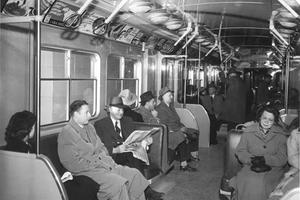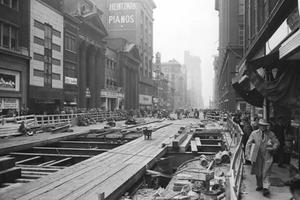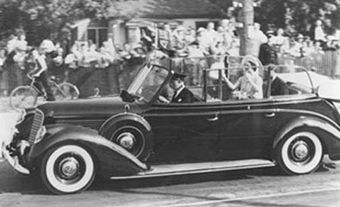This content is from a series created in partnership with Museum Services of the City of Toronto and Heritage Toronto. We gratefully acknowledge funding from the Ontario Ministry of Tourism, Culture and Sport, and the Department of Canadian Heritage.
Toronto Feature: Canada's First Subway
"Canada's first Subway"
The end of the Second World War in 1945 meant that the growth of the City of Toronto, suppressed after 15 years of depression and war, would suddenly explode. This prospect persuaded the Toronto Transit Commission (TTC) that bold action had to be taken to prevent the city from choking on its own traffic. On 8 September 1949, Ontario's Lieutenant-Governor Ray Lawson pushed a switch to drive the first steel pile into place at Yonge and Queen streets, on Canada's first underground transit line, the Yonge Street Subway.
Most of the subway was built using the "cut-and-cover" technique because it was far less expensive than boring a tunnel. As crowds gathered to watch, a large trench was dug into Yonge Street, utilities relocated, and steel cross members welded into place to support a deck that allowed traffic to return to the street while work proceeded beneath. It was a major disruption to Toronto's busy main street.
Ontario Premier Leslie Frost and Toronto Mayor Allan Lamport officially opened the Yonge Subway on 30 March 1954, at Davisville Station. It was a shining beacon of the optimism and growth of the post-war age. Still, TTC Chairman McBrien noted in his speech that the Yonge Subway was "not the final solution of Toronto's traffic problems. It is only the start of combating this monster." The comment is even truer 60 years later.

 Partager sur Facebook
Partager sur Facebook Partager sur X
Partager sur X Partager par Email
Partager par Email Partager sur Google Classroom
Partager sur Google Classroom





